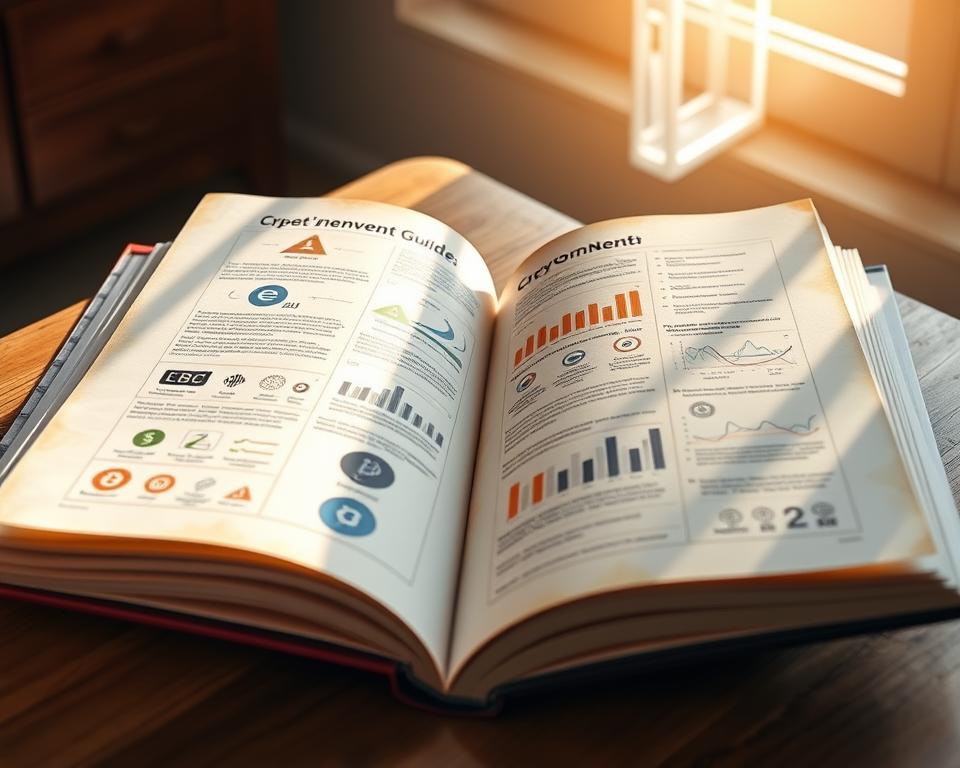
Optimal Cryptocurrency Trading Volume: What You Need to Know
Did you know that daily trading volume in cryptocurrency markets can hit over $100 billion? This huge number shows how important trading volume is for the success and stability of cryptocurrencies. Knowing about optimal cryptocurrency trading volume is key for investors wanting to make smart choices in a market full of ups and downs.
In this article, we’ll look into what makes a good trading volume for cryptocurrency and how it affects the market. We’ll use reliable sources like Investopedia and CoinMarketCap to explain how trading volume shapes your investment plans. It also helps in judging the worth of different digital assets.

Keep reading as we explore this vital part of the cryptocurrency market. We’ll reveal the secrets to making smart trading choices.
Key Takeaways
- Daily trading volume can surpass $100 billion in cryptocurrency markets.
- Optimal cryptocurrency trading volume is critical for informed investment decisions.
- Good trading volume reflects liquidity and market stability.
- Understanding trading volume impacts your investment strategies.
- Sources like Investopedia and CoinMarketCap provide valuable insights.
Understanding Cryptocurrency Trading Volume
Cryptocurrency trading volume is the total amount of a specific cryptocurrency traded in 24 hours. It shows how active the market is and how easy it is to buy and sell. When trading volume is high, it means many traders are interested, showing a healthy market.
Low trading volume, on the other hand, might mean the market is slow or not many people are interested. This can affect the price and how stable it is.
Knowing about trading volume helps investors understand the market better. A high volume means a cryptocurrency is widely used and prices are more stable. Investors look at past volumes to guess future prices and risks.

What is a Good Trading Volume for Cryptocurrency
Finding the right trading volume for cryptocurrency depends on many things. It’s about finding a balance that shows enough liquidity and activity. This makes it easier for people to trade without big price swings. Knowing these levels helps investors find good times to trade.
Defining Good Trading Volume
Good trading volume is based on a few key points. It looks at the cryptocurrency’s market cap and how easy it is to trade. A rule of thumb is that a daily volume should be 1-2% of the total market cap. This ensures assets can be bought and sold smoothly.
Factors Influencing Good Trading Volume
Many things can change what’s considered good trading volume:
- Market Sentiment: Good news can make people trade more.
- Historical Pricing: Big price changes can lead to more trading.
- External Events: News or tech updates can really move volumes.

Knowing these factors helps traders and investors make better choices. They can time their trades based on market trends and the best volumes.
| Categorie | Good Trading Volume Benchmark |
|---|---|
| Low Market Cap (Below $1 Billion) | 1-2% of market cap |
| Medium Market Cap ($1 Billion – $10 Billion) | 0.5-1% of market cap |
| High Market Cap (Above $10 Billion) | 0.2-0.5% of market cap |
Importance of Trading Volume in Cryptocurrency Markets
Understanding trading volume is key to knowing how cryptocurrency markets work. A good trading volume makes markets more liquid. This means easier buying and selling for traders.
More trading activity means smaller price differences between buying and selling. This makes trading cheaper and helps prices stay fair.
Market Liquidity and Its Role
Market liquidity depends a lot on trading volume. A liquid market lets trades happen fast without big price changes. This is good for traders who want to buy or sell without worrying about prices jumping.
For investors, a liquid market means less risk. This makes their strategies work better.
Price Volatility and Trading Volume
There’s a strong link between price volatility and trading volume. Big changes in trading volume often lead to quick price changes. When lots of buy or sell orders happen, prices can jump up or down a lot.
Active markets help find fair prices and prevent big price swings. This is important for traders who want consistent results.
Cryptocurrency Trading Volume Standards
Setting the right standards for cryptocurrency trading volume is key for traders and analysts. These standards help set expectations for what’s considered good trading activity on different exchanges. CoinMarketCap is a great resource for checking trading volume levels and their importance.
When looking at trading volume, we often use metrics like average daily volume and 24-hour trading volume. These numbers show how liquid a cryptocurrency is. Also, rules and regulations in the crypto world play a big role in setting these standards. Following these rules makes the trading environment more open and trustworthy.
Places like the Blockchain Research Institute share insights on trends and benchmarks in the crypto world. Knowing these standards helps traders make better choices. With a grasp of trading volume metrics, navigating the complex crypto world becomes easier.
Measuring Cryptocurrency Trading Volume
Understanding how to measure cryptocurrency trading volume is key for traders and investors. There are many metrics to track trading activity. This helps see how healthy the market is and how easy it is to buy and sell.
Common Metrics Used for Measurement
Several metrics are used to measure trading volume. The average daily volume shows how much currency is traded each day. It can show trends in market interest.
Market depth shows orders on exchanges. It gives insight into volume at different prices. Together, these metrics paint a clear picture of the volume landscape.
Tools for Tracking Trading Volume
Many tools help track trading volume, for both new and experienced traders. Platforms like TradingView offer guides for technical analysis. They make it easier to understand volume metrics.
CoinGecko also has analytics features. They let users watch trading volume over time. Using these tools helps make trading strategies more accurate.
How to Assess Trading Volume for Cryptocurrency
Understanding trading volume for cryptocurrency is key. It involves several practical steps. One way is to compare volume with price trends. When volume spikes match price movements, it shows strong market interest.
On the other hand, if prices change without volume, it might mean traders are unsure. This can affect your trading strategy.
It’s also crucial to watch different exchanges. Each platform has its own volume levels, affecting prices. Seeing which exchanges have the most liquidity helps you make better trades.
Keeping an eye on big volume changes is important too. A sudden increase in volume can signal price changes. Learning to read these signs helps you make smarter trades.
For investors, being proactive in these assessments is smart. Using these methods helps you understand cryptocurrency trading better.
Analyzing Cryptocurrency Volume Trends
Understanding cryptocurrency volume trends is key for traders. It helps them make smart choices in a fast-changing market. By looking at past trading volumes, traders can see how prices might move and when. This knowledge is crucial for predicting market trends and making smart investments.
Historical Volume Analysis
Looking at historical data is vital for analyzing trading volumes. Sites like CoinMarketCap offer detailed data for traders. This data shows how trading volume has changed over time.
By studying this data, traders can spot long-term patterns. These patterns help predict when the market might go up or down. This is especially useful when big events happen, like new rules or tech updates.
Current Market Trends
Today’s market trends show how cryptocurrencies are always changing. By looking at recent trading volumes, traders can see who’s active in the market. A rise in volume often means more people are interested, which could mean prices will keep going up.
But if volumes drop, it might mean people are losing interest or feeling tired. Watching these trends helps traders guess where prices might go next and what the overall mood is.
| Year | Average Trading Volume | Market Influence Events |
|---|---|---|
| 2018 | $5 billion | Regulatory scrutiny increased |
| 2019 | $10 billion | Major technological upgrades |
| 2020 | $18 billion | DeFi boom |
| 2021 | $30 billion | Institutional investments surge |
| 2022 | $25 billion | Market corrections and news volatility |
Ideal Trading Volume for Crypto Investments
Finding the right trading volume for crypto is key for all traders. This amount changes based on the trading strategy. Day traders need a lot of volume for quick trades without big price changes. They aim for volumes in the hundreds of thousands to millions of dollars daily.
Long-term investors look for stability over fast trading. They prefer a steady, lower volume to avoid big price swings. They often choose big names like Bitcoin and Ethereum, which have lots of trading activity.
Asset class also plays a role in what volume is ideal. Big cryptocurrencies need more volume than smaller ones. A high volume for big assets shows strong market interest.
| Investment Strategy | Ideal Trading Volume | Typical Market Cap |
|---|---|---|
| Day Trading | Hundreds of Thousands to Millions | Large Cap |
| Long-Term Holding | Stable with Lower Fluctuations | Small to Mid Cap |
| Swing Trading | Moderate to High | Varies |
In short, matching the investment volume with your strategy can boost your success. As the crypto market grows, knowing the right volume for your investments is crucial.
Assessing Optimal Trading Volume for Digital Assets
Looking into the best trading volume for digital assets gives us key insights. It helps us understand how to make smart investment choices. By studying trading cases, we see how volume affects market success. Many cryptocurrencies have grown a lot when their trading volume was high, teaching us important lessons.
Case Studies of Successful Cryptocurrencies
Some cryptocurrencies show how important the right trading volume is. By looking at these examples, we can spot trends and strategies that might help us do better in investing. Here are a few cryptocurrencies that saw big growth when their trading volume was high.
| Cryptocurrency | Trading Volume (24h) | Market Growth (%) | Factors Contributing to Growth |
|---|---|---|---|
| Bitcoin | $20 billion | 400% | Institutional adoption, increased media coverage |
| Ethereum | $15 billion | 350% | Smart contract implementations, DeFi growth |
| Cardano | $3 billion | 230% | Strong community support, successful upgrades |
These examples show why watching volume is crucial for a good trading plan. By learning from these cases, investors can match their trading with the best volume levels. This way, they might see similar success. The lessons from these examples help us navigate the complex world of cryptocurrencies.
Trading Volume Benchmarks for Cryptocurrency
Knowing about trading volume benchmarks for cryptocurrency is key for traders. These benchmarks help traders see how liquid and promising different digital assets are. There are different ranges for various cryptocurrencies, from top ones like Bitcoin and Ethereum to mid-tier and altcoins.
Top-tier cryptocurrencies usually have very high trading volumes, often over billions of dollars a day. This shows strong investor interest and better liquidity. Mid-tier coins might see trading volumes in the millions, showing moderate activity. Altcoins, being more volatile and less known, might have lower volumes but still draw interest when the market is right.
Traders can use blockchain analytics and financial reports to spot important crypto trading benchmarks. This helps them make smart investment choices. It’s important for investors to keep an eye on these benchmarks as the crypto market changes fast.
| Cryptocurrency Category | Typical Trading Volume | Investor Interest |
|---|---|---|
| Top-Tier | $1 billion+ daily | High |
| Mid-Tier | $10 million – $1 billion daily | Moderate |
| Altcoins | Below $10 million daily | Variable |
Understanding these trading volume benchmarks helps investors see the risks and rewards of different assets. Staying updated on these trends helps traders make better strategies and find success in the crypto market.
Factors Affecting Trading Volume in Crypto
The crypto market is shaped by many factors, each affecting trading volume. Knowing these factors affecting trading volume in crypto helps traders make better choices. Key influencers include regulatory news, macroeconomic events, tech advancements, and social media trends.
Regulatory updates can sway investor sentiment. Good news can boost trust and market participation. Bad news, on the other hand, can lead to a drop in trading activity.
Macroeconomic events, like economic downturns or policy changes, also matter. For example, during inflation, investors might turn to crypto as a safe haven. Knowing how these events impact volume can give traders an edge.
Technological progress is another key factor. New blockchain features or crypto innovations can spark interest. Features that make using crypto easier or safer tend to draw more users, boosting trading.
Social media trends can also drive market behavior. Viral content on platforms like Twitter and Reddit can greatly influence trading volume. Staying updated on trending content can help traders predict volume shifts.
| Factor | Description | Impact on Trading Volume |
|---|---|---|
| Regulatory News | Updates regarding laws and regulations related to cryptocurrency. | Can increase or decrease market trust, affecting participation rates. |
| Macroeconomic Events | Economic changes affecting global markets. | Influences investor behavior, impacting crypto as a safe haven or speculative asset. |
| Technological Advancements | Innovations that improve blockchain and cryptocurrency functionality. | Enhances user experience and attracts more traders. |
| Social Media Trends | Content and discussions that create buzz around specific assets. | Can dramatically spike interest and trading activity. |
Strategies for Optimizing Trading Volume
Traders need effective strategies to boost their trading volume and profits. A good trading plan uses volume indicators to guide decisions. Adapting to market changes helps traders use new opportunities, increasing their volume.
Developing a Trading Plan
A good trading plan includes many elements to handle volume changes. It focuses on data-driven decisions by identifying key metrics. Traders should set volume targets and test their strategies before using them.
Adapting to Market Changes
Being quick to adjust to market changes is key for traders. Keeping up with news, trends, and volume patterns helps spot market shifts. Traders who adjust their strategies well can grab new opportunities.
Common Misconceptions About Cryptocurrency Trading Volume
Understanding trading volume can be tough, and many myths exist in the market. One big myth is that high trading volume means a healthy market. But, it can also show manipulation on some platforms. This can lead to investors making bad choices based on wrong data.
Another myth is about liquidity. Many think high volume means easy trading. But, liquidity changes a lot between different currencies and exchanges. Sometimes, fake high volume can trick traders into thinking they can easily buy and sell.
Some also believe trading volume always affects prices. But, it’s not the only factor. News and market mood also play big roles. Knowing this helps traders understand data better and make smart choices.
Future Trends in Cryptocurrency Trading Volume
The world of cryptocurrency trading is set for big changes. New technologies and market shifts are key players. We need to look at what the future holds for trading volume.
Advanced tech like artificial intelligence and blockchain analytics will change the game. They can make trading smarter and more efficient. This could lead to more trading happening.
Rules from governments are also important. Clearer laws can make people more confident in trading. This can lead to more activity in the market.
More people are starting to see the value in cryptocurrencies. This is thanks to more awareness and companies using them. This growth can change how we see trading volume.
Big financial players getting into crypto is a big deal. Their support shows that digital assets are serious investments. This can make more people want to trade.
As the market grows, these trends will shape our understanding of trading volumes. It’s an exciting time for cryptocurrency trading.
Conclusion
In this summary, we looked at the key points of cryptocurrency trading volume. It’s important for understanding market liquidity and price changes. It also helps in making better trading plans.
We talked about how to measure volume and how to use it for better trading. A detailed review of trading volume can help you make smarter choices. It shows how knowing the right volume can help you succeed in the crypto market.
Now that you know more about cryptocurrency trading volume, use this knowledge to improve your strategies. With this information, you can make choices that help you succeed in the changing crypto world.
FAQ
What is a good trading volume for cryptocurrency?
A good trading volume for cryptocurrency depends on the asset’s market cap. A volume over $1 million is often seen as healthy. But, this can change based on the cryptocurrency type and market conditions.
How do I assess trading volume for cryptocurrency?
To assess trading volume, look at historical data and price trends. Also, watch for any big changes that might show shifts in market mood. Using platforms like CoinMarketCap or TradingView can give you useful insights.
What factors influence good trading volume?
Good trading volume is influenced by market sentiment, news, price trends, and liquidity. High volume shows strong investor interest and confidence.
Why is trading volume important in cryptocurrency markets?
Trading volume is key because it shows market liquidity. It makes buying and selling easier and helps keep prices stable. High volume also signals a strong price trend, which is important for traders.
What are common metrics used for measuring cryptocurrency trading volume?
Common metrics include average daily volume, market depth, and volume over time. These help traders understand market activity and liquidity better.
How can I track cryptocurrency trading volume?
You can track volume through platforms like CoinGecko and CoinMarketCap. They offer detailed analytics. Charting tools on platforms like Binance or Kraken also help track volume.
What are trading volume benchmarks for cryptocurrency?
Trading volume benchmarks vary by category. Top-tier cryptocurrencies usually have high benchmarks, while mid-tier and altcoins have lower ones. This depends on their market cap and status.
What are some misconceptions about cryptocurrency trading volume?
Some think high volume means a stable market or guarantees profits. But, liquidity and price manipulation can affect volume perceptions.
How do current market trends affect trading volume?
Current trends, like regulatory news and technological advancements, impact volume. As investor sentiment changes, so does trading activity.
What strategies can I use for optimizing trading volume?
For better volume, create a trading plan using volume indicators. Stay updated with market changes and use tools to track patterns. This helps make informed decisions.







